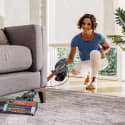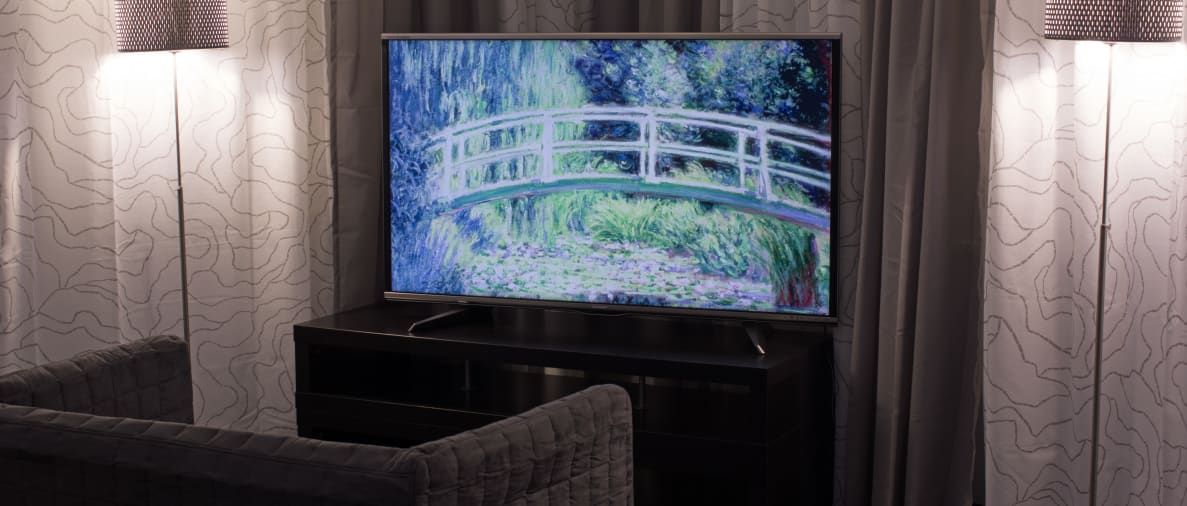Just like the SQ15U, the UQ17U is an eccentric sort of television—there are enough picture controls here to make it look however you want—but from a traditional standpoint, the UQ17U is actually quite good. Testing revealed just average contrast, but also solid color accuracy and motion performance.
Toss in decent smart features, a big screen, and the added benefit that the UQ17U can receive and display a 4K signal, and you've got a pretty good deal for the price. In fact, the 60-inch UQ17U is currently on sale for $1,999, and we can see it piquing the interests of many buyers. The SQ17U series is also available in 70- and 80-inch iterations.
The Picture
A well-equipped machine
When I reviewed the Sharp SQ15U, the series one step down from this one, I was surprised by how excessively blue it was. Ideally, a TV's backlight will exhibit strict neutrality in terms of coloration, so that content creators—like directors and cinematographers—have the final artistic say in a product. Fortunately, the UQ17U is much better in this regard, and overall is a strong performer.
When watching in the dark, things look great in the TV's THX-certified Movie pre-set. The backlight locks at ideal luminance for a home-theater environment, which helps the UQ17U maintain healthy black levels. Overall, there isn't a ton of contrast, but it's plenty for dark-room viewing. My one complaint about watching in this kind of environment is that the backlight bleeds through at the TV's corners, marring the uniformity of black bars during letterbox or 4:3 (standard definition) content. It's not the worst I've ever seen, but it is distracting.
In terms of color production, the UQ17U is spot-on. While neutral tones like gray and white are tinged with a little blue out of the box, this is very easy to fix during calibration. Reds, greens, blues, and everything in-between are vivid and rich without obscuring valuable details. If you like a little extra color, the TV's built-in color selector allows for a wider, more saturated color space.
I am especially impressed with the UQ17U's motion performance. I watched a good deal of The Dark Knight on Blu-ray and found that, for the most part, action-heavy sequences were easy to follow; every shattering window and gob-smacked villain rendered in stellar detail, no matter how hard old Bats hit them. When the caped crusader went sailing around a building, the horizontal movement caused some judder, but turning on the TV's AquoMotion 960 mode did wonders to smooth it out without aggressive interpolation. Best of all, that motion setting dims the backlight just a little, which really helps clear up the backlight bleed.
Finally, the office also played Super Smash Bros. for a few days using the TV's Game picture mode and found a minimal amount of input lag, even when upscaling a 480i (standard definition) game. All in all, the UQ17U is a very capable television. If you're a purist, you can easily prime the TV for home-theater viewing, where balanced colors and satisfying contrast rule the day. If you'd rather take things up a notch, the included Resolution Enhanced processor and Dynamic modes make for a bright, flashy, and fun TV experience.
For a full run-down of our test results and calibration settings, check out the Science Page.
The Looks
Low rider
Sitting low to the tabletop is a signature look for Sharp TVs, and the UQ17U is no exception. Instead of the wing stand found on the company's lesser models, however, the top-tier UQ17U stands on two sleek silver feet. These angled, wide-set wedges balance the panel and have a cutting, modern appearance.
Like other Sharp TVs this year, the top and lower bezels are finished with a brushed metal, but the side bezels are solid black. This increases the prevalence of the horizontal versus the vertical plane, emphasizing the modern aspect ratio of the screen.
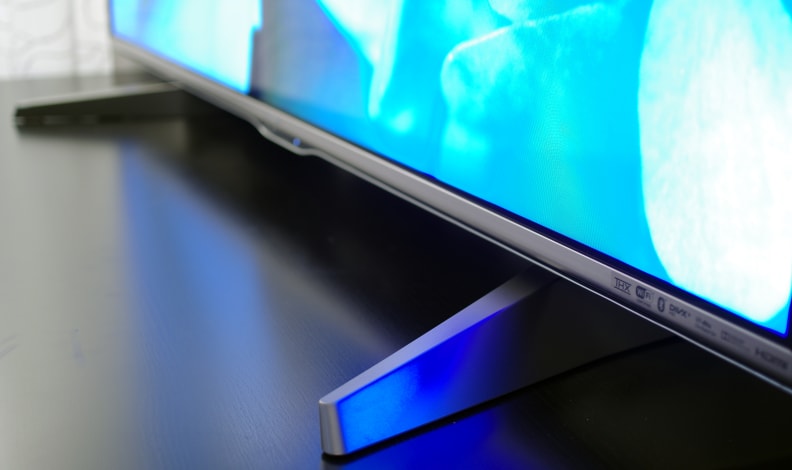
The slanted, wedge-shaped feet look modern while providing good support to the hefty 60-inch panel.
The LC-60SQ17U gives you plenty of video and audio connections, too. An L-shaped area on the rear, left side of the TV offers up four HDMI, two USB inputs, analog audio out, PC audio in, digital audio out, a coaxial jack for cable/antenna, and an ethernet (LAN) input. A small, recessed area nearby houses one component and two composite inputs, as well as VGA (RGB) in and an RS-232 control jack.
Alongside the panel and stand components, you'll find a remote control and two pairs of active 3D glasses. The remote is the usual black plastic with lots of buttons, but pops of color—maroon for the power button, blue for volume, green for channel—keep it slightly more interesting than usual. The length of the remote means you have to adjust a lot to easily access all of the buttons with one thumb, but the infrared functionality is quite reliable, at least.
{{ photo_gallery "design" }}
The Experience
Content a-plenty, but lacking in the style factor
Smart Central 3.0 is Sharp's new-and-improved 2014 smart platform, allowing users to browse the web, search for shows, or watch Netflix with ease. There's nothing about Smart Central that will blow you away, but it doesn't have any major drawbacks, either.
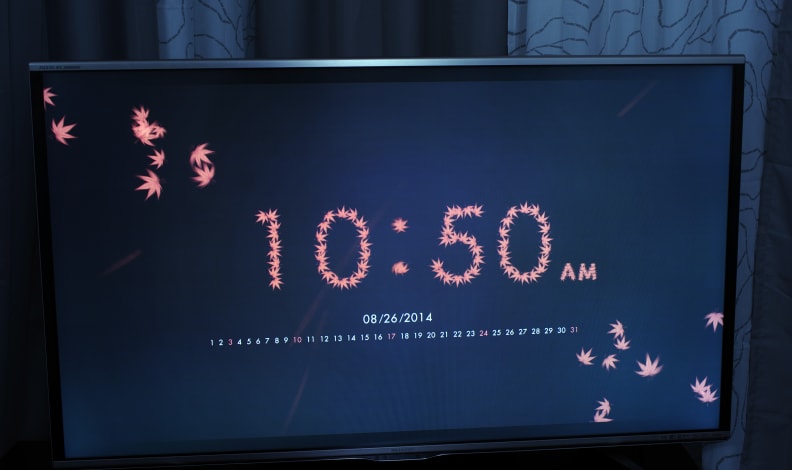
Wallpaper Mode is one of this TV's coolest features. Most TVs just look like plain black rectangles when they aren't in use, but the UQ17U can display paintings or seasonal clocks on low power if you so desire—giving your living room a more decorative overall look.
Plug in an ethernet cable or hop onto your home WiFi and you're good to go. Pressing the Smart Central button on the remote levels a selection of apps along the bottom of the screen. The first time you use the TV, these apps will default to things like Netflix, Hulu Plus, Facebook, or the web browser, but they'll slowly transform into your most-used apps over time.
If you press the Smart Central button again, a home screen appears with three tabs: TV, Streaming, and Apps. After you choose your cable/satellite provider, the TV tab shows you on-air programs as well as the day's scheduled programs. The Streaming tab is similar, except instead of pulling content listings from cable, it pulls available TV shows and movies from your streaming subscriptions, like Netflix and Hulu. Finally, for everything else—flash games, weather apps, money advice—there's the Apps tab.
As for the on-board menu software, it's a mixed bag. The UQ17U isn't really missing anything in terms of content, but it lacks a cohesive sense of style. Users will find the same picture settings and audio options from the company's SQ15U, meaning the same blocky white text and uninspired layout. The LC-60UQ17U would have all of the trimmings of a premium TV if it weren't for the unintuitive, ugly menu software.
{{ photo_gallery "software" }}
The Verdict
One of the sharper tools in the shed
For $2,399 (or $1,999 online right now), the UQ17U brings a lot to the table. From flashy, near-4K rendering to a tasteful, traditional film look, the UQ17U is varied enough that most consumers will find a setup they love. The Smart Central 3.0 platform brings plenty of goodies, too, even if it isn't the slickest option on the market. And if anyone out there is still gung-ho about 3D, well, it does that too.
The real selling point, however, is the TV's ability to receive a 4K (UHD) signal. It might seem excessive now, but in three years you could be thanking your lucky stars you sprung for a Quattron+ model.
If you don't think you'll need that option, however, there are much cheaper TVs with similarly svelte performance. For example, Vizio's 60-inch M Series is about $1,000 less, and Samsung's 60-inch H6350 is $1,200 on Amazon. It really depends on what you need—just keep in mind that the UQ17U is uniquely future-proofed.
Behind The Screens
The Sharp LC-60UQ17U (MSRP $2,399) is a solid performer with a wide range of assets. I looked past the glitzy sub-pixel matrix, 3D capability, and extra color to see how this TV performed in the most difficult environment—a pitch-black room—and was pleasantly surprised by what I found. Decent contrast bolstered by healthy black levels, solid color accuracy, and a quick, breezy calibration confirmed the UQ17U's viability in a cinephile's den.
Contrast Ratio
Contrast is perhaps the most important element of a truly immersive picture. Great differentiation between a TV's brightest and darkest elements creates depth for the eyes, resulting in a picture that's more realistic. A TV's contrast ratio, determined by dividing its peak brightness by its black level, is often a telling sign of how enjoyable it is to watch overall.
The UQ17U performed alright here, though it certainly didn't go above and beyond. I measured a solid black level of 0.06 cd/m2 using an ANSI checkerboard pattern, coupled with a peak brightness of 127 cd/m2 in the Movie (THX) picture mode. While this isn't terribly bright, it's plenty for a home-theater environment. The resulting contrast ratio of 2116:1 is viable, though not overly impressive.

The UQ17U tested with a good black level in the THX-certified Movie mode, although its overall contrast ratio is only average.
Viewing Angle
Our viewing-angle test measures how far from center you can watch a TV before the picture degrades beyond comfortable viewing. We measure full-field contrast patterns, starting at the center of the screen and moving in 10° increments until the contrast measured plummets below 50% of its head-on value.
The UQ17U tested with an average total viewing angle of 56°, or ±28° from the center to either side of the screen. This is slightly worse than the comparison models in the same screen size, but overall means a smaller group can comfortably watch this TV without overt picture degradation. Just don't expect to spread out all over the room.
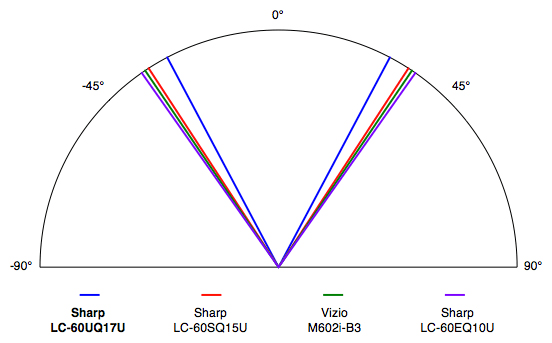
The UQ17U tested with a total viewing angle of 56°, or ±28° from center to either side of the screen.
Color Gamut
A color gamut illustrates a TV's color accuracy when compared to a standard. To look their best and display content with integrity, TVs should produce color that's in-line with the Rec. 709 HDTV color specifications.
In this regard, the UQ17U is a strong performer. Prior to calibration, I tested fairly accurate colors in the Movie (THX) mode, though white, gray, cyan, and magenta skew towards blue. Correcting the TV's sub-pixel balance using the 2-point white balance control fixed this blue tendency, while also adding a little extra saturation to green.
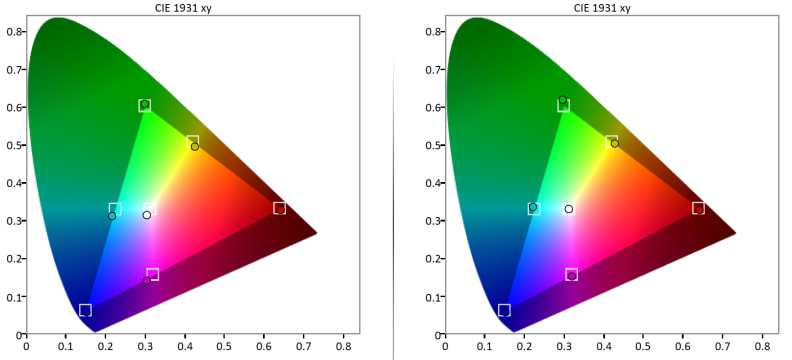
The UQ17U exhibits accurate colors, though secondaries tend to skew towards blue more than they should.
Grayscale & RGB Balance
A TV's grayscale refers its neutral gradations from black to gray to white. Digital displays create these neutral shades by combining three primary colors (red, green, and blue). Because they use this kind of additive color, TVs sometimes struggle to display grayscale elements with proper neutrality when one or more primary colors is over- or under-emphasized.
Because it over-emphasized blue a little too much out-of-the-box, the UQ17U exhibited some grayscale error, a sum of 8.57 (3 or less is deal). Removing the excess blue reduced the grayscale error to 1.57.

The UQ17U over-emphasizes blue, which results in a fair amount of error within neutral tones.
Closer inspection of the UQ17U's sub-pixel emphasis explains the overall grayscale error: By default, the TV simply over-emphasizes the presence of the blue sub-pixel in a traditional RGB matrix. Reducing blue's presence in the signal resulted in more natural-looking black, gray, and white tones.
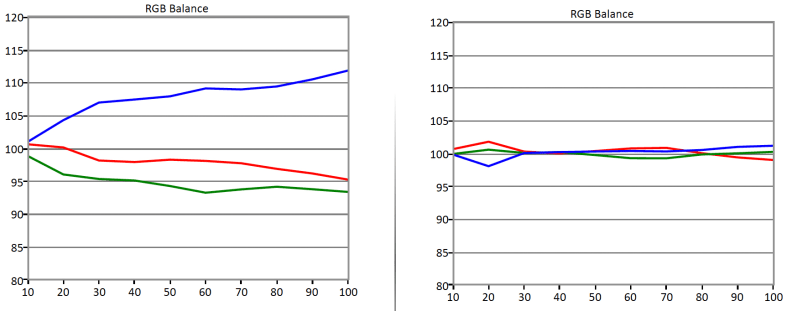
After calibration, the UQ17U adheres much more strictly to ideal sub-pixel emphasis.
Gamma
A gamma curve describes how a TV "corrects" a digital light output for our infinitely better analog vision. Basically, a TV naturally brightens from black to gray to white in set, even increments, but because of how our eyes work, this straight curve must be corrected so that increments are more or less subtle in how they change luminance.
Prior to calibration, the SQ17U tested with a gamma curve of 2.33, which is good for a dimmer room, or even one with normal ambient lighting. It tends to get a little too bright as it travels out of middle gray into bright whites. I calibrated the TV to a gamma curve of 2.42, which is closer to the ideal for a pitch-black room, but it exhibited the same problem, brightening too much around the middle steps of the grayscale.

Both before and after calibration, the UQ17U brightens a little too quickly from black to white, but this is a very mild aberration.
Meet the tester
Lee was Reviewed's point person for most television and home theater products from 2012 until early 2022. Lee received Level II certification in TV calibration from the Imaging Science Foundation in 2013. As Editor of the Home Theater vertical, Lee oversaw reviews of TVs, monitors, soundbars, and Bluetooth speakers. He also reviewed headphones, and has a background in music performance.
Checking our work.
Our team is here for one purpose: to help you buy the best stuff and love what you own. Our writers, editors, and lab technicians obsess over the products we cover to make sure you're confident and satisfied. Have a different opinion about something we recommend? Email us and we'll compare notes.
Shoot us an email